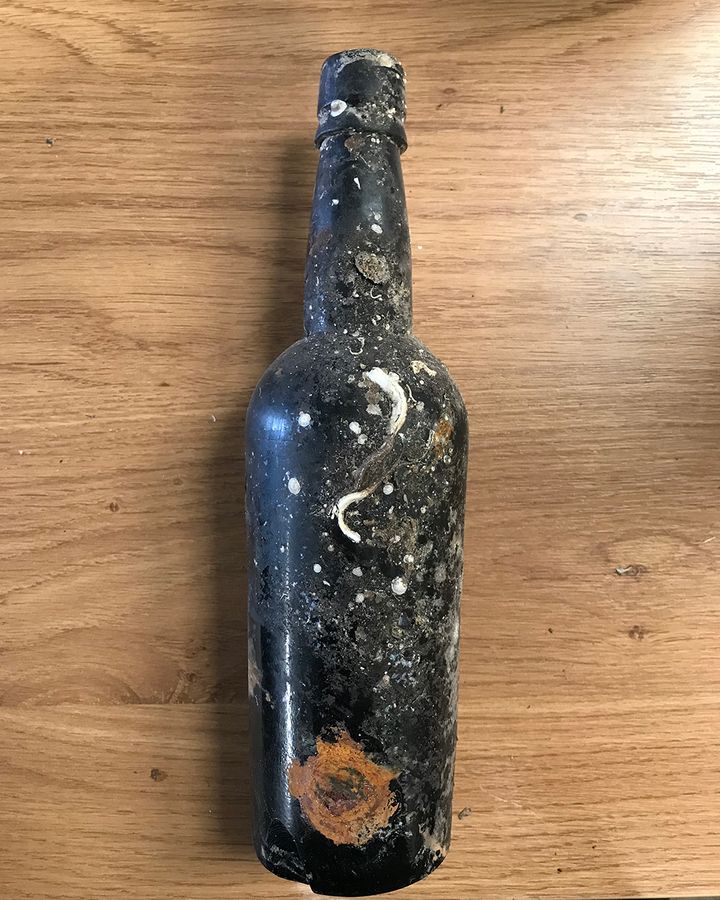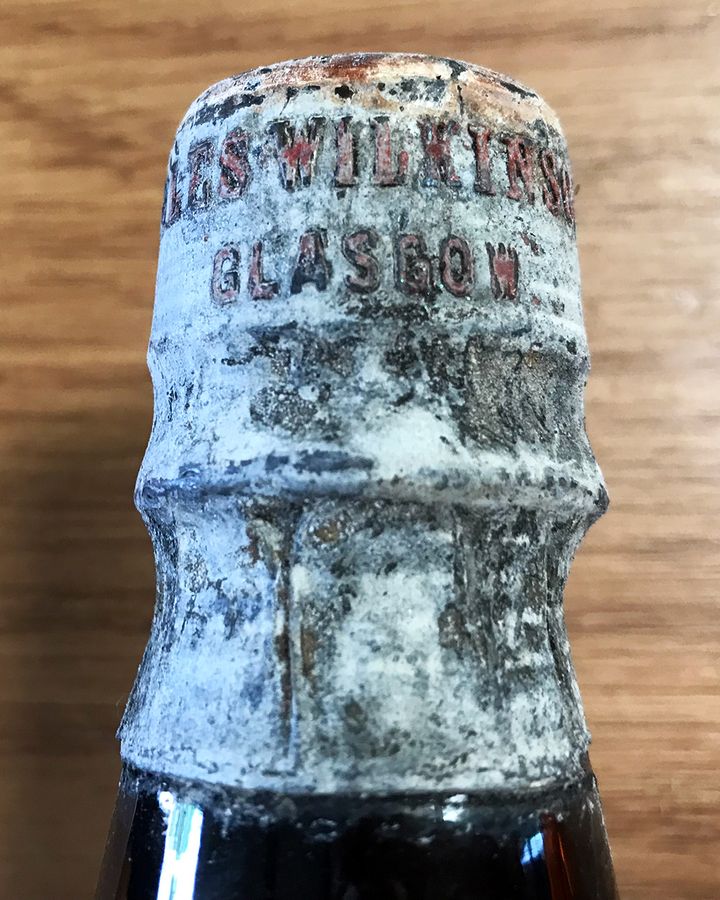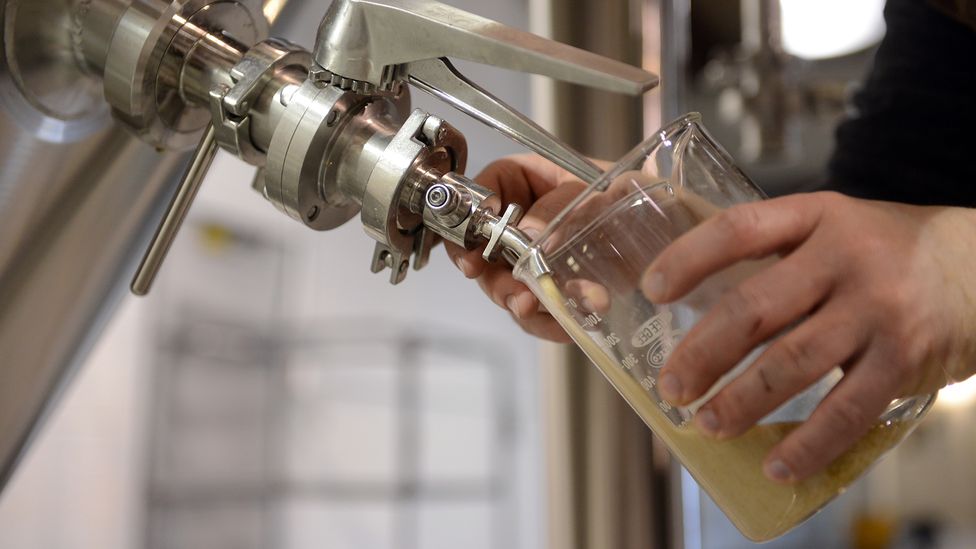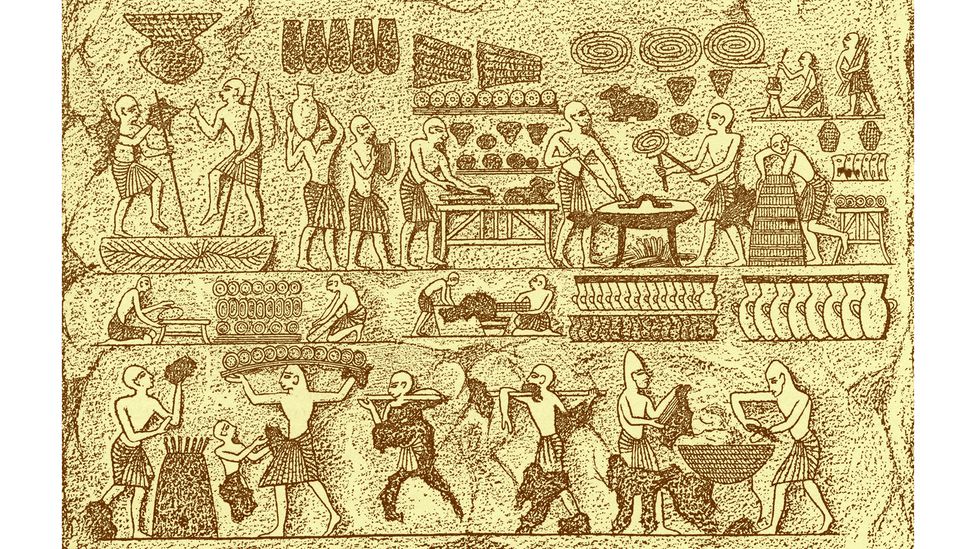Long-forgotten yeast strains are being sought out from shipwrecks, abandoned breweries and other locations in the hope they could be put to good use if resurrected.
A
As the diver gently eased himself through a hatch into the sunken hold, he could see the shipwreck's treasure lying in wait for him. It had been down there for more than 100 years. But now some of it was about to be freed from its resting place.
The explorer in question, Steve Hickman, a dive technician and amateur diver, carried a small, netted bag with him. The treasure he was after was beer. Preserved in the hold of this vessel were row upon row of glass beer bottles, partly buried in silt.
As soon as he moved the first bottle from where it lay, sediment billowed in huge clouds. With visibility reduced to nil, Hickman was effectively blinded. But he knew this wreck well and had visited it many times before. He carried on, feeling for more bottles in the gloom. Once he had gathered and bagged a few, he made his escape and his team carefully carried the bottles to the surface.
The wreck was the Wallachia, a cargo ship that sank in 1895 off the Scottish coast following a collision with another vessel in heavy fog. The Wallachia had just departed from Glasgow and was packed with various kinds of cargo, including large containers of a chemical called tin chloride. But the ship also had thousands of bottles of alcoholic beverages aboard. Many of them have been preserved in the cold water where the ship lay on the silty seabed for more than a century.
Since he began diving to the Wallachia in the 1980s, Hickman has retrieved dozens of bottles containing whisky, gin and beer. But his recent visit, a team effort with several companion divers, led to something unusual. The bottles they retrieved were handed to scientists at a research firm called Brewlab, who, along with colleagues from the University of Sunderland, were able to extract live yeast from the liquid inside three of the bottles. They then used that yeast in an attempt to recreate the original beer.
In 2018, a similar project in Tasmania used yeast from 220-year-old beer bottles found on a shipwreck to approximate a beverage from the 1700s. But the study of the Wallachia yeast revealed a surprise. Those beers contained an unusual type of yeast and the team behind the work is now evaluating whether this long-lost strain could have applications in modern brewing or could even improve beers today.

When opened, the beer inside the bottles found on the Wallachia had a far from appetising odour, but the yeast they contain could be invaluable (Credit: Steve Hickman)
It is just one example of a growing field of research among brewers and other fermenters of liquids who are seeking forgotten strains of yeast in the hope they can be put to good use. That means hunting for them in old bottles found on shipwrecks, scouring ancient pots, and collecting samples from ruined distilleries where fabled strains may yet linger. This kind of search is called bioprospecting and resurrecting historic yeasts could have many applications, from cleaning up pollution to assisting in the production of aromas for the perfume industry.
When Steve Hickman first began gathering bottles of beer from the Wallachia back in the 1980s, he claims it was still – just about – drinkable. He and his friends brought the bottles home and poured them out into glasses. The beverage, nearly 100 years old at the time, settled slowly and developed a thick, creamy head – almost like Guinness, he recalls. But that's where the magic ended.
"It had the most atrocious smell," says Hickman. "A sort of salty, putrefied smell. I think that would be the best description." It didn't taste any better, he adds.
The bottles had other surprises – including a habit of exploding, says Hickman. As they adjusted to the lower pressure above sea level, gases inside the vessels expanded, occasionally shattering the glass. Once, Hickman left a bottle on the kitchen table in his parents' house. It burst while they were in another room, spraying stinking, decaying beer everywhere. It took a long time to clean up, he remembers.
Nowadays, the beer has deteriorated even further and he wouldn't attempt sipping it. (As a general point, drinking old liquids might not be safe because you can't be sure whether they contain harmful bacteria or chemicals.) However, some of Hickman's diving companions were able to taste fresh beer created by Brewlab using strains of yeast isolated from the old Wallachia bottles. Andy Pilley, a chartered surveyor and fellow amateur diver who was also on the expedition to collect beer from the wreck, was among those who tried the result: a 7.5% stout.
"I certainly got coffee and chocolate from it," he says. It was Pilley who decided to send the Wallachia beer to Brewlab, after he heard about the company by chance at a restaurant.
Scientists at Brewlab, a spin-out from the University of Sunderland, have studied yeast strains and brewing techniques for years. The firm's founder, Keith Thomas, says that once beer from the Wallachia was in his lab, it was treated with the utmost caution.
"We opened it in containment level two laboratory conditions," he says. This involved unsealing the bottles in a special cabinet filled with sterile air, in order to protect the scientists from any possible pathogens in the beer. This measure also ensured that the samples did not become contaminated with any modern-day yeast strains.
You might also like:
Genetic testing revealed that the Wallachia stout contained two different types of yeast – Brettanomyces and Debaryomyces. In a paper about the work, Thomas and his colleagues explain that it's unusual to find Debaryomyces in an historic beer, though this type of yeast has turned up in a few Belgian beers made using spontaneous fermentation, which relies on leaving pre-fermented liquid open to the environment, so that yeast strains may settle on it.
Some of the most common yeast strains used in brewing are from the species Saccharomyces cerevisiae. Generally, fermentation occurs when yeasts consume the sugars in malted grains like barley. The yeast turns these sugars into alcohols, carbon dioxide and various by-products. Some of those by-products impart flavour and so each individual yeast strain, metabolising in its own way, will yield a different flavour profile in the fermented product. It all comes down to the genome of the strain in question, or strains, plural, in the case of the Wallachia beer.

Many of the bottles found on board the Wallachia remained unopened despite spending more than 100 years underwater (Credit: Steve Hickman)
Most modern brewers don't vary the yeast they use a great deal, though they do commonly experiment with other ingredients such as the grain they ferment, or the hops they add later in the process to impart flavour.
A few beverage-makers and scientists argue that using more diverse strains of yeast can also strongly influence the flavour and robustness of the finished product. In short, trying an unusual yeast could result in better beer, so many are turning to forgotten strains from the past.
Thomas is pleased with the results of the Wallachia beer study. He says the combination of the two yeasts they found in the 126-year-old beer could perhaps inspire innovations in the brewing industry today. The yeasts seem to impart a sort of farmyard or "wet horse" character, he adds. This might not sound particularly appetising but, in moderation, earthy flavours like that could help a skilled brewer come up with a unique, richly flavoured beverage.
Brewing is, after all, a balancing act. Consider sour beer. Too much sourness would naturally be off-putting but, at the right level, it can make for a refreshing concoction.
Brewers do experiment with alternatives to Saccharomyces cerevisiae – Brettanomyces strains, for example, are often used to make sour beers, for instance. But there are many unexploited yeast strains out there just waiting for brewers to discover them, argues Carmen Nueno-Palop at the National Collection of Yeast Cultures (NCYC), part of the Quadram Institute in the UK.
"There's been a lot of emphasis on hops," she says, referring to recent innovations in the beer industry. She notes, however, that some brewers might produce multiple different beers – all using exactly the same yeast. "I want to transmit to brewers the importance of choosing the right strain," she adds.
About four years ago, Nueno-Palop and her colleagues conducted an experiment in which they brewed 33 beers that were all basically identical – save for the yeast. The team chose a different strain for each beer and began by analysing the strains' DNA, which turned out to be unexpectedly diverse.
"I was very surprised," she says. "They were all different from each other."
The resulting beers also varied greatly in terms of their flavour profiles.
The NCYC has around 600 beer brewing strains in its archives, some of which were deposited by UK breweries faced with closure during economic difficulties in the 1950s and 1960s. Some of these strains have barely been used since, if at all. Nueno-Palop says brewers are now beginning to recognise that they can diversify their products perhaps by using a strain that has some historical connection to their location in the UK.
This idea, that historic yeasts can impart heritage as well as interesting flavours, is catching on outside of the beer world. Alan Bishop has the title of alchemist and lead distiller at Spirits of French Lick, a distillery in Indiana, in the US. The company makes a range of boutique spirits, including bourbon, apple brandy, rum and gin.
In recent years, Bishop has gone bioprospecting in the hope of collecting abandoned yeast strains at former distilleries in Indiana and Kentucky. He usually brings a jar of mash or wort, the liquid containing sugars from the grain that will be fermented, to these derelict sites. He simply leaves this open to the air. Yeast then naturally settles on the wort, allowing fermentation to begin.

Researchers have found that changing the yeast used during brewing can impart exciting new flavours to the beer (Credit: Ryan McFadden/Getty Images)
Now and again, Bishop has also swabbed the insides of old jugs at disused distilleries, retrieving yeast directly from inside. There are so many defunct distilleries near to him, he says, because the cottage industry of whisky and bourbon producers that existed in the US during the 1800s went out of business thanks to prohibition – a period between 1920 and 1933 when the production, importation and sale of alcoholic beverages was made illegal across the US.
Bishop has not yet sent any of his bioprospected strains for genetic analysis and so can't be sure of their exact provenance.
But either way, he's certain that using alternative yeasts makes a difference to the beverages he and his colleagues produce. For example, one particular strain that he gathered from the site of the Daisy Spring Mill distillery in an Indiana state park confers potent cinnamon flavours to the fermenting spirit, he says.
With this experimentation comes an opportunity to develop new and interesting beverages but it also links Spirits of French Lick to the local area and its distilling heritage, argues Bishop. In general, he thinks distillers are missing a trick by not seeking out more varied yeast strains for their production.
"There's not been a whole lot of attention put on yeast in distillation, unfortunately. At least in the past 100 years or so," he says. "Each one of these yeast varieties has its own characteristics."
He argues that the differences in flavour that develop in fermenting spirit won't disappear even after it has been processed and matured in casks for months or years.
Yeast diversification could benefit all sorts of other industries. It could, for example, help perfume makers come up with better fragrances. Yeasts are sometimes used to produce the complex chemicals in a scent when they cannot be easily obtained from other ingredients. In recent years, genetically modified yeasts designed to do this have become available on a large enough scale to be used in commercial production. Among those pioneering this approach is the synthetic biology company Ginkgo Bioworks in the US.
Thomas notes that that Debaryomyces yeast found in the Wallachia beer also appears to be tolerant of heavy metals such as arsenic and lead. That might mean that it would make a good bioremediation yeast – one used to absorb pollutants in a contaminated environment, to clean it up. Parts of the world where arsenic-contaminated groundwater has been linked to health problems include the Middle East, India and the west coast of South America, says Thomas.
Another area that might benefit from bioprospected yeasts is pharmaceuticals. Many medicines are made with the help of yeasts, which are used to grow certain chemicals. Some suggest that even more efficient yeasts for this purpose could be found in the environment – perhaps in the sea.
Bread-makers could also turn to new – in fact, old – yeasts, in a quest to diversify their products. In 2020, Seamus Blackley, the creator of the original Xbox video game console, announced that he had recreated an Egyptian loaf of bread using yeast cultures sampled from ancient Egyptian baking containers.
Two scientists who helped Blackley in the endeavour are still in the process of researching Egyptian yeast strains and analysing the genetic makeup of yeast used in that experiment, in order to find out what contribution any ancient strains might have made to the bread. Blackley says that the team intends to launch a more extensive DNA sampling programme, in order to analyse other artefacts and archaeological sites.
But because it exists as a living thing in an ever-changing environment, it's difficult to know for sure that a yeast strain sampled from the wild really is descended directly from one used in historic food production, says Caiti Smukowski Heil at North Carolina State University.
That's one reason why shipwrecks are so special, she notes, because if you can extract yeast from a sealed bottle that has been in dark, cold and stable conditions for many years, you can be confident you have retrieved the original yeast used to make that product.

Ancient Egyptians were among the first to bake bread, but the yeasts they used were likely to be different from those around today (Credit: Lebrecht Music & Arts/Alamy)
Either way, there is a "humungous diversity of untapped yeasts" out there, she says. Commercial bakers, for instance, largely rely on standard strains of Saccharomyces cerevisiae. But wild yeasts or historic strains that have fallen out of use could actually be better options for modern production.
"Species of yeast outside Saccharomyces cerevisiae are often more tolerant of things like using frozen dough and sometimes even have increased leavening ability," says Heil.
Thomas says he wants to sample and study yeast from sealed vessels found on yet more shipwrecks, or other, well-preserved, boozy time capsules. And by studying the genetics of old yeast strains, it might also be possible to identify previously unknown but desirable genes, which could influence genetically modified yeast in the future.
But the wreck of the Wallachia is a sobering reminder of just how lucky we are to have access to a handful of historic yeasts that we can confidently associate with a specific time and place. In the 30 or so years since Hickman has been diving to it, he's witnessed how the wreck has deteriorated over time. Structures and walkways above and around the engine room have collapsed. Cracks in the ship's ageing walls have widened. The vessel is fading away.
"I would suspect that, possibly within the next 20 to 30 years, it will be completely gone," he says.
The Wallachia will likely take its remaining beer bottles with her as she slowly breaks apart on the seabed. A valuable link to the brewers of the 19th Century will finally be gone forever, taking the precious yeasts it carries in various long-forgotten bottles of booze with it.
--
Join one million Future fans by liking us on Facebook, or follow us on Twitter or Instagram.
If you liked this story, sign up for the weekly bbc.com features newsletter, called "The Essential List". A handpicked selection of stories from BBC Future, Culture, Reel, Worklife, and Travel, delivered to your inbox every Friday.

